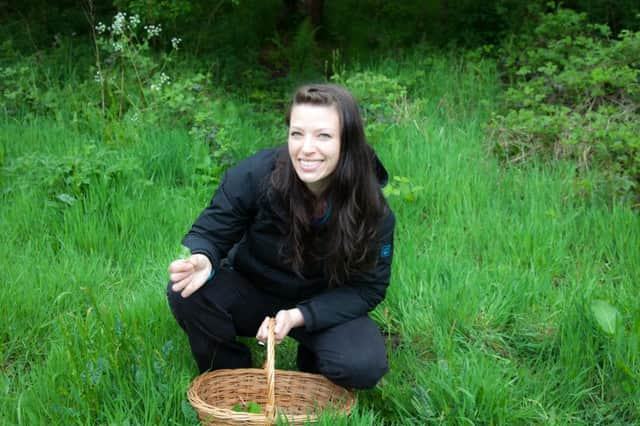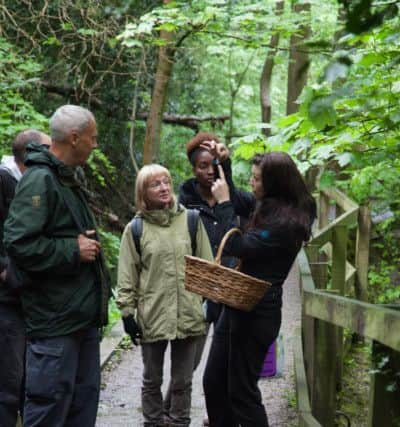Witch's egg and other food you can forage from larder at bottom of the street


Cities are not the first place I think of foraging for food but Lisa puts me right. “There can easily be 40-50 different edible species of plants in a typical park. Foraging isn’t just about nettles and blackberries, there’s so much more. There are edible seeds, leaves, flowers, fungi, roots, shoots and fruits with the most amazing shapes, flavours and textures to be found.”
Our four-hour forage begins with a safety briefing and a gentle stroll, dodging rain showers as we go. There are five others in our group – seven-year-old Jacob Dent who has come along with his grandfather Neil; Inava Iman, a student studying Arabic and International Relations at the University of Leeds; and David and Barbara Hudson from South Yorkshire who have been given the course as a gift. We haven’t walked far before I see Lisa pointing to a slim branch of beautiful pink flowers. “Cherry blossom makes a wonderful marzipan-flavoured syrup. The Japanese celebrate cherry blossoms, regarding their brief flowering period as a metaphor for the transience of life.”
Advertisement
Hide AdAdvertisement
Hide AdI know a few edible wild plants, but it is not long before Lisa takes me into unfamiliar territory as she points out a shrub bearing masses of tiny, brilliant orange flowers. “This is one of my favourite plants, Darwin’s barberry. The flowers are surprisingly tangy, and there will soon be bunches of small, blue berries hanging below the spiny stems. They taste tart but make a delicious vinegar.”


In a patch of earth the simple white flowers of alpine strawberries push up from their leaves. In a few weeks they will form tiny strawberries tasting like bubblegum.
Lisa’s interest in nature began with her parents and grandparents. She remembers poring over their field guides on wildflowers, butterflies and birds at her family home in Winchester, near the New Forest. She went on to study biology at Leeds University.
“Nearly all my meals contain a foraged ingredient. I even top an ‘emergency’ shop-bought pizza with wild garlic pesto and weeds from the garden when I haven’t got time to cook.”
Advertisement
Hide AdAdvertisement
Hide AdAbout 15 years ago Lisa learned the highly-prized porcini mushroom Boletus edulis grew in the UK and made it her mission to find one. It took several years but sparked an interest in finding and identifying wild fungi. “Mushrooms are fun because you have to really study them and they’re more elusive and less predictable than plants, meaning finding edible fungi is all the more rewarding.”


Lisa’s enthusiasm is infectious. She spots another plant growing in the grass. Unprompted, young Jacob tells us “it’s a ribwort plantain”. Delighted by his knowledge, she explains: “You can eat the green bud before the halo of tiny white flowers appears, they’re great in a stir-fry. You can also use the mature seeds in breads and seed mixes.”
As we shelter beneath an ash tree from another shower Lisa offers us tiny jars of pickled ash keys and wild garlic flower buds to taste. We crunch the samples and savour the delicately-sweetened pickling mixture. They taste wonderful.
We meander in a loose crocodile formation into a thickly-wooded area where we discover patches of wood sorrel with heart-shaped leaves, arranged in threes, and bearing tiny white flowers. We taste the delicate leaves and I am struck by the zingy, citrus flavour. “That’s the oxalic acid you can taste. Wood sorrel is delicious in salads,” Lisa tells us.
Advertisement
Hide AdAdvertisement
Hide AdMy favourite find was the winding tendrils and purple flowers of common vetch which tasted of fresh garden peas. We found mint and watercress growing by a stream. “These should always be picked from above the waterline,” Lisa advises.
We spotted bistort, a kind of dock used to make the traditional West Yorkshire dish “dock pudding”; coltsfoot flowers used to make cough medicine; and jack-by-the-hedge, a delicious garlic-and mustard-flavoured leaf.
The most curious thing we sampled were slithers of immature stinkhorn known as a witch’s egg – found clustered around the roots of a wind-felled tree.
I was also fascinated by the tiny, golden disc-shaped seeds of common hogweed, which taste of bitter oranges. Lisa uses them to flavour panna cotta, tagine and spiced cakes.
Advertisement
Hide AdAdvertisement
Hide AdWe ended with a gastronomic finale sitting at a picnic bench. Sipping cups of steaming linden-blossom tea, we slathered homemade goat’s cheese, flavoured with five different types of wild garlic, on crisp biscuits with chutneys, tucked into lilac cupcakes, crunched through crystallised douglas fir needles and sampled lilac blossom vodka.
And what was the point of this foraging? I was reminded in our age of ready meals, fast food and obesity how much more there is to food than buying it off the shelf in a supermarket. I learned about the importance of seasons, how food grows, the range of natural flavours in wild plants and how to use common wild foods in my everyday recipes.
I will keep in mind the wise words of Michael Pollan, food activist and author of Food Rules who advises: “Eat wild foods when you can.” They are some of the most nutritious, tasty foods around.
• www.eduliswildfood.co.uk